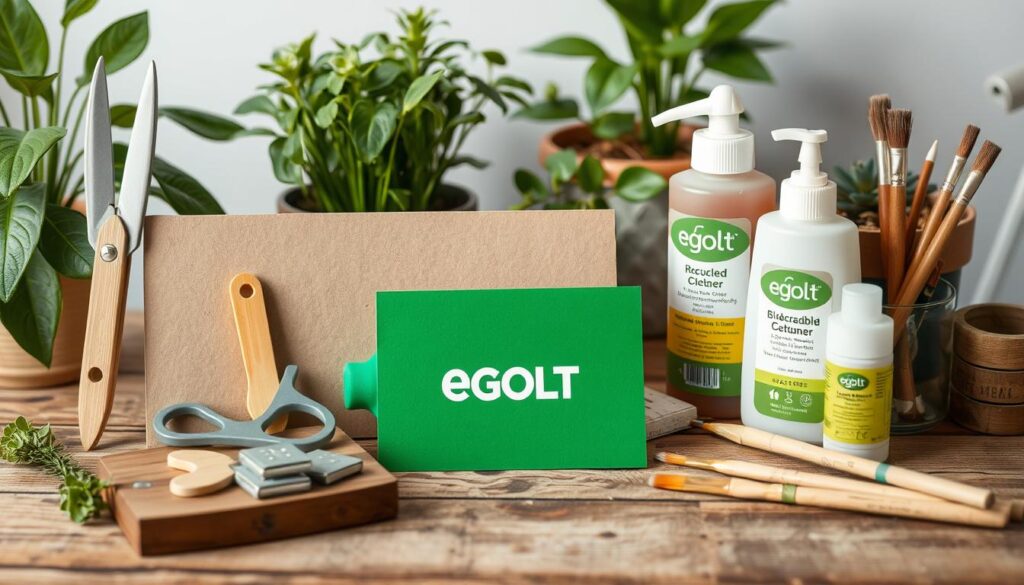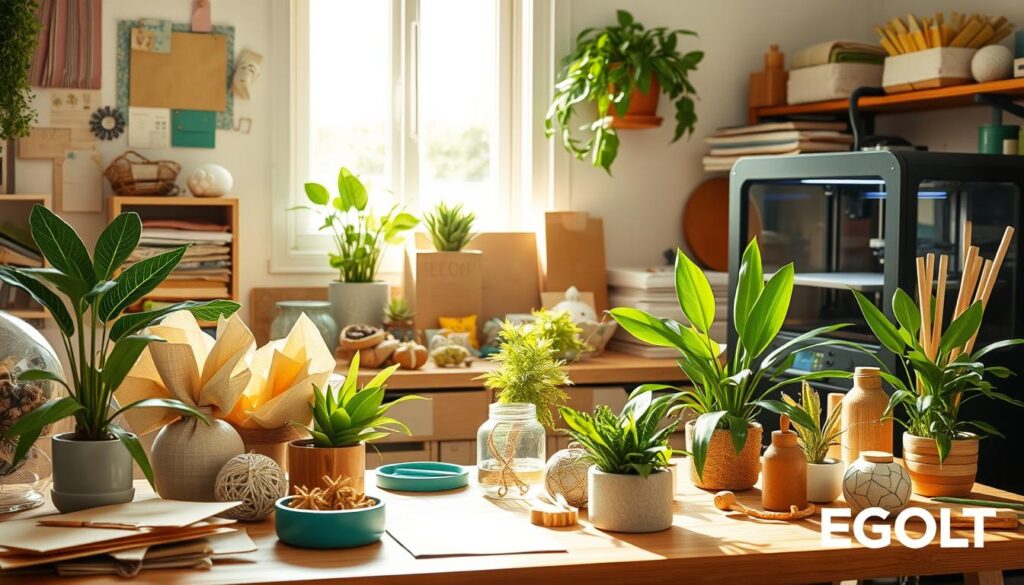Crafting and creating have long been cherished hobbies, allowing us to express our creativity and individuality. But as we become more conscious of our environmental impact, many crafters are seeking ways to make their pursuits more eco-friendly. Welcome to the world of sustainable crafting, where we’ll explore creative solutions to reduce waste, minimize our carbon footprint, and embrace a greener approach to our beloved handmade projects.

In this article, we’ll delve into the benefits of sustainable crafting and uncover practical tips to help you transform your crafting journey into an eco-friendly adventure. From selecting the right materials to upcycling everyday items, you’ll discover a wealth of ideas to make your crafting process more sustainable. Let’s embark on this green crafting expedition together and find innovative ways to indulge in our passions while respecting the planet we call home.
Understanding Sustainable Crafting
In the realm of crafting, a growing movement known as “mindful making” has emerged, championing the principles of sustainable creativity. Sustainable crafting is a holistic approach that considers the environmental, economic, and social impact of our creative pursuits. By embracing this mindset, we can cultivate a more conscious creativity that not only enriches our lives but also contributes to a healthier planet.
What Is Sustainable Crafting?
Sustainable crafting is the practice of creating artful objects while minimizing the use of resources, reducing waste, and promoting ethical and eco-friendly practices. It encompasses the careful selection of materials, the adoption of energy-efficient techniques, and the responsible disposal or reuse of materials at the end of a project’s lifecycle.
Benefits of Sustainable Crafting
- Environmental Benefits: Sustainable crafting reduces the ecological footprint of our creative pursuits, conserving natural resources, and mitigating the impact on the environment.
- Economic Benefits: By embracing sustainable practices, crafters can save money through the efficient use of materials and the prolonged lifespan of their tools and equipment.
- Social Benefits: Sustainable crafting fosters a sense of community, as like-minded individuals come together to share knowledge, resources, and a passion for conscious creativity.
At the heart of sustainable crafting is the desire to create mindfully, making deliberate choices that respect the planet and our shared future. By adopting these principles, we can transform our crafting habits into a meaningful journey of mindful making, one that enriches our lives and contributes to a more sustainable world.
Choosing Eco-Friendly Materials
When it comes to sustainable crafting, the choice of materials is crucial. Exploring the differences between natural fibers and synthetics, as well as the benefits of recycled and upcycled materials, can help you make informed decisions that align with your eco-friendly goals.
Natural Fibers vs. Synthetics
Natural fibers, such as cotton, wool, and linen, are often considered more sustainable than their synthetic counterparts like polyester and nylon. Natural fibers are biodegradable, renewable, and generally require less energy to produce. In contrast, synthetics are typically derived from non-renewable petroleum sources and can be less environmentally friendly during the manufacturing process.
Recycled and Upcycled Materials
- Incorporating upcycled materials into your crafts is a great way to give new life to discarded items and reduce waste.
- Look for repurposed fabrics, paper, and other materials that can be transformed into unique and creative repurposed crafting projects.
- Exploring local thrift stores, second-hand shops, and online marketplaces can be a treasure trove of affordable and eco-friendly materials.
Sourcing Locally
Reducing your carbon footprint is another important aspect of sustainable crafting. Sourcing materials locally, from small businesses or independent artisans, can help minimize the environmental impact of transportation and support your local community. Take the time to research and connect with local suppliers who offer sustainable options for your crafting needs.
| Material | Sustainability Factors | Sourcing Recommendations |
|---|---|---|
| Cotton | Renewable, biodegradable, requires less energy to produce | Local textile mills, organic cotton farms |
| Wool | Renewable, biodegradable, requires less energy to produce | Local sheep farms, small-scale wool producers |
| Recycled plastics | Reduces waste, conserves natural resources | Local recycling centers, upcycling workshops |
Creative Upcycling Ideas
Sustainable crafting isn’t just about using eco-friendly materials – it’s also about finding innovative ways to breathe new life into everyday items. From transforming common household goods to repurposing old clothing, the possibilities for zero-waste DIY projects are endless.
Transforming Everyday Items
Ordinary objects can be the canvas for creative upcycling. Turn glass jars into vibrant vases, transform cardboard boxes into stylish storage containers, or revamp worn-out furniture with a fresh coat of paint. The key is to approach each item with an open mind and a touch of imagination. With a little creativity, even the most mundane items can be transformed into unique, one-of-a-kind pieces.
Upcycling Clothing into New Designs
Clothing is another goldmine for green craft ideas. Old t-shirts can be repurposed into reusable grocery bags, worn-out jeans can be turned into stylish tote bags, and threadbare sweaters can be felted and stitched into cozy mittens or hats. By embracing the art of upcycling, you can give new life to garments that would otherwise end up in the landfill, all while creating beautiful, sustainable pieces.
| Everyday Item | Upcycled Idea |
|---|---|
| Glass Jars | Vases, Storage Containers |
| Cardboard Boxes | Organizers, Wall Art |
| Old Furniture | Refurbished, Repurposed |
| T-Shirts | Reusable Grocery Bags |
| Jeans | Tote Bags, Denim Crafts |
| Sweaters | Felted Mittens, Hats |
Sustainable Tools and Equipment
When it comes to ethical handmade and sustainable crafting tips, the tools and equipment you use play a crucial role. Investing in eco-friendly alternatives can not only reduce your environmental impact but also improve the longevity of your crafting tools.
Selecting Eco-Friendly Tools
Look for tools made from renewable, recycled, or upcycled materials. Opt for bamboo handles, stainless steel blades, and soy-based finishes. Avoid products with plastic components whenever possible. Additionally, seek out tools that are designed to be repaired or refurbished, minimizing waste over time.
Maintaining Your Tools for Longevity
- Clean and care for your tools regularly to extend their lifespan.
- Sharpen blades and replace worn parts to keep them functioning at their best.
- Store tools properly to prevent rust, damage, and deterioration.
- Invest in tool maintenance accessories, such as sharpeners and oilers, to prolong their use.
By choosing ethical handmade tools and prioritizing their maintenance, you can reduce your environmental footprint and ensure your crafting supplies serve you well for years to come. Sustainable crafting is not just about the materials you use, but also the tools that bring your creations to life.

Eco-Conscious Crafting Techniques
As eco-friendly enthusiasts, we understand the importance of minimizing our environmental impact, even in the world of crafting. The good news is that there are plenty of sustainable techniques we can adopt to make our creative pursuits more mindful and eco-conscious. Let’s explore some practical ways to conserve resources and reduce waste while indulging our passion for eco-friendly crafts and mindful making.
Water-Saving Techniques
Water is a precious resource, and we should be mindful of its usage in our crafting projects. Consider the following water-saving techniques:
- Use a small, dedicated container for water-based activities like dyeing or painting, rather than running water from the tap.
- Recycle and reuse water when possible, such as using the same dye bath for multiple projects.
- Opt for dry-cleaning methods for fabrics and textiles, reducing the need for excessive water usage.
Reducing Waste While Crafting
Minimizing waste is a key aspect of sustainable crafting. Implement these strategies to optimize material usage and minimize waste during your creative endeavors:
- Plan your projects carefully to reduce material consumption and cut down on unused scraps.
- Repurpose and upcycle existing materials, such as transforming old clothing into new craft projects.
- Invest in reusable tools and equipment to avoid single-use items.
- Properly dispose of or recycle any unavoidable waste, such as excess paint or fabric trimmings.
By embracing these eco-conscious crafting techniques, we can reduce our environmental footprint and contribute to a more sustainable future, all while indulging our creative passions. Let’s make eco-friendly crafts and mindful making a way of life!
Sustainable Project Ideas for Beginners
Embarking on a sustainable crafting journey doesn’t have to be intimidating, even for novices. From easy-to-follow DIY projects to family-friendly activities, there are plenty of green craft ideas to get you started on your eco-friendly hobby.
Simple Craft Projects to Start With
If you’re new to sustainable crafting, try your hand at these simple yet rewarding projects:
- Handmade greeting cards using recycled materials
- Upcycled tote bags from old t-shirts or denim
- Homemade beeswax wraps to replace plastic wrap
- Repurposed jar candles made with natural wax and essential oils
Family-Friendly Crafting Activities
Sustainable hobbies can be a great way to bond with your loved ones while promoting green craft ideas. Try these eco-friendly activities the whole family can enjoy:
- Decorative nature wreaths made with foraged materials
- Seed-embedded paper planting to grow your own herbs or flowers
- Colorful vegetable stamping for vibrant, nature-inspired artwork
- Upcycled bird feeders crafted from recycled containers
By starting with these simple and family-friendly projects, you can explore the joys of sustainable crafting while making a positive impact on the environment. Embrace your creativity and discover the endless possibilities of green craft ideas that align with your eco-conscious values.
Crafting with Nature
Embracing the beauty and serenity of the natural world, conscious creativity takes on a whole new dimension when you incorporate eco-friendly crafting techniques. By using natural elements in your projects, you can not only create stunning, one-of-a-kind pieces but also reduce your environmental impact.
Using Natural Elements in Your Projects
Imagine the possibilities when you bring the outdoors in! Leaves, flowers, stones, and other natural materials can be transformed into breathtaking works of art. From delicate pressed flower collages to whimsical leaf-adorned jewelry, the options are endless. Experiment with natural pigments and dyes to imbue your creations with the vibrant hues of nature.
Creating Eco-Friendly Art
- Explore the use of biodegradable and non-toxic materials, such as beeswax, soy-based paints, and natural fibers, to craft your eco-friendly masterpieces.
- Upcycle found objects and repurpose discarded items into unique, sustainable art pieces that tell a story of conscious creativity.
- Embrace the imperfections and organic textures of natural materials, allowing them to inspire and guide your creative process.
By tapping into the beauty and serenity of nature, you can unleash your conscious creativity and craft sustainable, eco-friendly works of art that not only delight the senses but also inspire a deeper connection with the natural world.
| Natural Materials | Eco-Friendly Techniques |
|---|---|
| Leaves, flowers, stones, twigs, bark | Natural dyes, biodegradable adhesives, upcycling |
| Soy-based paints, beeswax, natural fibers | Pressed flowers, leaf imprinting, nature-inspired designs |
Incorporating Technology Responsibly
In the pursuit of sustainable crafting, technology plays a vital role in empowering eco-conscious creators. From digital design tools to virtual workshops, the integration of technology can help reduce the environmental impact of traditional crafting practices while fostering innovation and creativity.
Digital Design Tools for Eco-Crafts
Advances in digital design software have revolutionized the way crafters approach their projects. Sustainable crafting enthusiasts can now leverage digital design tools to create intricate designs, experiment with patterns, and minimize material waste. These tools enable crafters to visualize their concepts, refine their ideas, and make informed decisions about material usage and production methods, all while minimizing their carbon footprint.
The Benefits of Virtual Workshops
The rise of virtual workshops has opened up new avenues for sustainable crafting education and collaboration. By embracing online platforms, crafters can connect with like-minded individuals from around the world, share techniques, and learn from experts without the need for extensive travel. This not only reduces the environmental impact associated with transportation but also fosters a global community of sustainable crafting enthusiasts, empowering them to explore zero-waste DIY projects and discover sustainable crafting tips from the comfort of their own homes.

By harnessing the power of technology, sustainable crafters can streamline their creative process, reduce resource consumption, and build a more eco-conscious community. As the world continues to evolve, the responsible integration of digital tools and virtual platforms will undoubtedly play a crucial role in shaping the future of sustainable crafting.
Packaging and Shipping Sustainably
In the world of ethical handmade and repurposed crafting, thoughtful packaging and shipping practices play a crucial role in maintaining the eco-friendly integrity of your creations. As conscientious crafters, we have a responsibility to minimize the environmental impact of our products’ journey from our hands to our customers’ doorsteps.
Choosing Eco-Friendly Packaging Options
When selecting packaging materials for your ethical handmade or repurposed crafting items, consider the following eco-friendly alternatives:
- Recyclable and biodegradable cardboard or paperboard boxes
- Compostable packaging made from plant-based materials like cornstarch or bamboo
- Recycled and FSC-certified paper or tissue paper for wrapping and cushioning
- Reusable, durable containers like tin cans or glass jars
Minimizing Shipping Waste
Reducing the environmental impact of shipping your ethical handmade and repurposed crafting creations involves several strategies:
- Use the smallest possible packaging to fit your items, minimizing excess space and materials.
- Prioritize local and regional shipping options to reduce the carbon footprint of long-distance transportation.
- Offer customers the option to forgo unnecessary packaging, such as gift wrapping, to cut down on waste.
- Encourage the reuse and recycling of your packaging materials by providing clear instructions.
By thoughtfully considering your packaging and shipping practices, you can ensure that your ethical handmade and repurposed crafting creations maintain their sustainable and eco-friendly essence throughout their journey to your customers.
Sustainable Crafting Communities
Connecting with like-minded individuals who share a passion for sustainable hobbies and mindful making can be a rewarding experience. Discovering local eco-craft groups and engaging with online forums are excellent ways to explore the world of sustainable crafting.
Finding Local Eco-Craft Groups
Seek out community centers, art studios, and environmental organizations in your area that host sustainable crafting workshops and meetups. These groups often provide a welcoming space to learn new skills, exchange ideas, and collaborate on eco-friendly projects. Joining a local sustainable hobbies group can be a great way to expand your horizons and connect with fellow mindful makers.
Online Forums for Sharing Ideas
- Explore online communities dedicated to sustainable crafting, such as dedicated subreddits, Facebook groups, or specialized forums.
- These platforms offer a wealth of information, tutorials, and inspiration from experienced crafters who are passionate about sustainable hobbies and mindful making.
- Engage with the community by sharing your own projects, asking questions, and offering advice to fellow eco-conscious creators.
| Online Forum | Focus | Membership |
|---|---|---|
| r/SustainableCrafting | Sustainable hobbies, mindful making | Over 50,000 members |
| Eco-Friendly Crafters | Eco-conscious DIY projects, upcycling | 15,000+ members |
| Sustainable Living Crafts | Nature-inspired crafts, zero-waste techniques | 8,000+ members |
By engaging with sustainable crafting communities, both locally and online, you can discover new techniques, find inspiration, and connect with a supportive network of like-minded individuals who are committed to mindful making and eco-friendly hobbies.
Hosting Sustainable Craft Events
As the sustainable crafting movement gains momentum, eco-conscious individuals are seeking out opportunities to gather, share ideas, and showcase their *conscious creativity*. Hosting sustainable craft events is an excellent way to foster this growing community and promote *green craft ideas*.
Organizing Eco-Friendly Workshops
When planning sustainable craft workshops, focus on using recycled, upcycled, or locally sourced materials. Encourage participants to bring their own materials, and provide a resource list of eco-friendly suppliers. Incorporate techniques that minimize waste, such as zero-waste cutting patterns or water-saving dyeing methods.
- Prioritize hands-on learning over passive demonstrations
- Offer tutorials on repairing and maintaining crafting tools
- Invite local artisans to share their sustainable practices
Tips for Green Craft Fairs
Organizing a sustainable craft fair requires attention to every aspect of the event. Encourage vendors to use biodegradable or reusable packaging, and provide recycling and composting stations on-site. Promote the use of public transportation or carpooling, and consider offering discounts to attendees who arrive by eco-friendly means.
- Utilize renewable energy sources, such as solar power, to power the event
- Partner with local organizations to donate any unsold items
- Incorporate educational displays or workshops to raise awareness about sustainability
By hosting sustainable craft events, you can inspire and empower a community of eco-conscious makers, artists, and enthusiasts to explore the boundless possibilities of *conscious creativity* and *green craft ideas*.
Educating Through Crafting
Crafting can be a powerful tool for educating people about sustainability. By incorporating eco-friendly practices into our creative pursuits, we can raise awareness and inspire others to adopt more sustainable lifestyles.
Raising Awareness About Sustainability
Through eco-friendly crafts, we can showcase the benefits of sustainable living and encourage others to make conscientious choices. From upcycling discarded materials into unique home decor to using natural dyes and fibers in our projects, each creative endeavor can serve as a conversation starter about environmental consciousness.
Collaborating with Local Organizations
Partnering with local environmental organizations can further amplify the impact of our sustainable crafting tips. By hosting workshops, participating in community events, or collaborating on educational campaigns, we can reach a wider audience and inspire collective action towards a greener future.
By embracing the power of crafting, we can nurture a culture of sustainability and empower individuals to make a positive difference through their creative pursuits.
The Future of Sustainable Crafting
As the demand for eco-friendly and sustainable practices continues to grow, the world of crafting is witnessing a remarkable transformation. Emerging trends in sustainable crafting point to a future where creativity and environmentalism go hand in hand. From the increasing popularity of upcycled materials to the rise of zero-waste DIY projects, the landscape of crafting is evolving to prioritize sustainability.
Trends to Watch in Eco-Crafting
One of the most exciting trends in sustainable crafting is the widespread embrace of upcycling. Crafters are discovering innovative ways to transform discarded or repurposed items into unique and functional pieces. This not only reduces waste but also encourages a more mindful approach to resource utilization. Additionally, the growing interest in local and artisanal crafts has led to a surge in support for small, eco-conscious businesses and makers.
Innovations in Eco-Friendly Materials
Alongside the rise of upcycling, the development of innovative eco-friendly materials is shaping the future of sustainable crafting. From biodegradable and compostable alternatives to traditional craft supplies to the exploration of natural and renewable resources, the options for environmentally conscious crafting are expanding. These advancements not only reduce the environmental impact of crafting but also inspire crafters to rethink their material choices and embrace more sustainable solutions.



